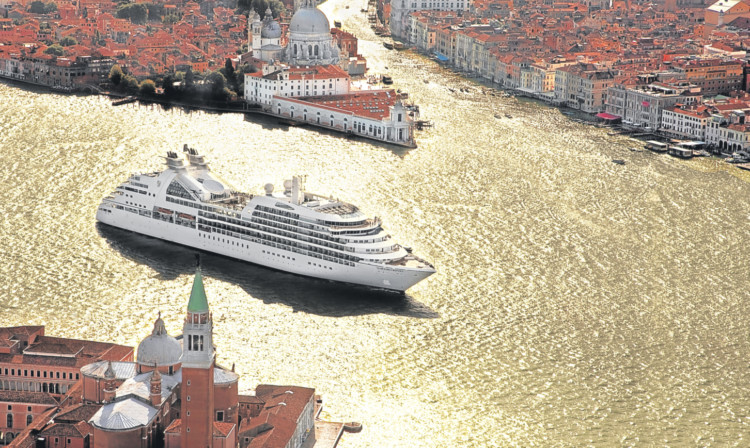
Last week I wrote about the fabulous Seabourn Odyssey, so this week I’m talking about the ports we visited on our cruise.
First stop was pretty Gythion, in Greece, reached by tender from the ship.
Deciding not to take an organised excursion, we strolled round the port admiring the pastel-tinted houses, which haphazardly make their way up the foothills of Mount Koumaros.
This is the small port town for Sparta. According to Homer, Paris and Helen spent their first night together here, on a tiny islet in the bay. To commemorate the occasion, Paris erected a shrine to Aphrodite, goddess of love, only to have it torn down by the vengeful Menelaus after he recaptured Helen.
To the north of Gythion lie Sparta and Mystras, both well worth a visit. After an hour or two, the delights of the ship beckoned and, after a relaxing evening, we set sail for Katakolon.
This small commercial port serves the inland town of Pyrgos and 15 miles in the distance lies Olympia, the sacred ancient site where the Olympic Games were born.
Again we opted to DIY and took a 45-minute train journey to Olympia.
Today, this UNESCO World Heritage Site is a peaceful place, shaded by plane trees, poplars, oaks and pines. The athletes and spectators are long gone and the temples are now ghosts of their glorious past, but the Olympic tradition lives on.
The Olympic flame is still kindled at this ancient site every four years and the Olympic torch begins its journey where runners carry it in relay to the site of the next Games.
Here you also find an archaeological site and museum. Guides show you where the athletes practised for their events and where the races were run. Athletic contests ended here in AD 393, the temples were destroyed and the great Sanctuary of Zeus was lost to time.
The next port was pretty Parga. It curls around a sandy beach between two rugged outcrops. Brightly painted houses ascend the slope to a Venetian Castle and a clamber up there is well worth it for the view. The hills surrounding the town are dotted with quaint churches and forested with ancient groves with some of the largest olive trees in Greece. It is a beautiful port, but you don’t really need an excursion as it’s easy to explore on your own.
The next day was at Dubrovnik in Croatia,and you can read all about the “Pearl of the Adriatic” in a separate article next year, but suffice to say it is one of the most stunning cities in Europe.
The Croatian island of Hvar was next another gem. Now home to the wealthy yachting set and many celebrities, Hvar is beautifully situated on a large natural bay.
The ancient town of Hvar served as an important harbour for Venice’s Adriatic fleet from the 12th to the 18th Centuries. Vestiges of this momentous time are reflected in the fortifications that still stand guard over the harbour and in the very heart of the port where you find a large arsenal.
Hvar today is a quiet spot, reminiscent of the French Riviera at the turn of the 19th Century. Sail and fishing boats bob and sway in the harbour and a 17th Century bell tower tolls out the hours.
Inland, Hvar’s green hills are dotted with vineyards and lavender fields and offshore, tiny islets are scattered like pearls on a clear cobalt sea. No wonder this is a yachtsman’s paradise destination.
Our final port of call before ending in Venice was Ravenna in Italy, where we opted to take one of Seabourn’s excursions to visit Bologna.
A scenic 75-minute drive takes you to one of Italy’s oldest cities. Once an ancient Etruscan and then a Gallic settlement, this beautiful and intriguing city eventually became a Roman municipality. It proclaimed itself a Free Common during the Middle Ages and that independent spirit endures to this day. The University of Bologna, founded in 1088, was established within its walls and is the world’s oldest University in continuous operation.
The heart of Bologna is the Piazza Maggiore. View the Palazzo del Podeste and the Palazzo Comunale, and in the adjoining Piazza del Nettuno, you’ll see the Palace of King Enzo, built in 1244.
The most impressive building in the square is the Basilica of San Petroni, built between the 14th and 17th Centuries. This is one of the largest basilicas in Christendom and one of the finest examples of Gothic architecture in all of Italy.
Continuing your walk along Via Archiginnasio and you’ll see the palace that once served as the University. Then, making your way to the splendid Basilica of Santo Stefano, you will discover a complex of buildings erected between the 11th and 13th Centuries. From here you will proceed to one of the most famous features of Bologna, the Leaning Towers. Needless to say, we had spaghetti bolognese for lunch.
That’s the great thing about a cruise, you feel as if you’ve had one holiday after the other. You cram in so much to a short space of time, but it’s upto you what pace you take it at.
We loved our Seabourn cruise, and this itinerary was a real winner.

Enjoy the convenience of having The Sunday Post delivered as a digital ePaper straight to your smartphone, tablet or computer.
Subscribe for only £5.49 a month and enjoy all the benefits of the printed paper as a digital replica.
Subscribe